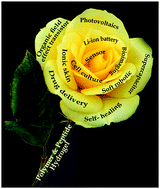A review on recent advances in polymer and peptide hydrogels
Abstract
In this review, we focus on the very recent developments on the use of the stimuli responsive properties of polymer hydrogels for targeted drug delivery, tissue engineering, and biosensing utilizing their different optoelectronic properties. Besides, the stimuli-responsive hydrogels, the conducting polymer hydrogels are discussed, with specific attention to the energy generation and storage behavior of the xerogel derived from the hydrogel. The electronic and ionic conducting gels have been discussed that have applications in various electronic devices, e.g., organic field effect transistors, soft robotics, ionic skins, and sensors. The properties of polymer hybrid gels containing carbon nanomaterials have been exemplified here giving attention to applications in supercapacitors, dye sensitized solar cells, photocurrent switching, etc. Recent trends in the properties and applications of some natural polymer gels to produce thermal and acoustic insulating materials, drug delivery vehicles, self-healing material, tissue engineering, etc., are discussed. Besides the polymer gels, peptide gels of different dipeptides, tripeptides, oligopeptides, polypeptides, cyclic peptides, etc., are discussed, giving attention mainly to biosensing, bioimaging, and drug delivery applications. The properties of peptide-based hybrid hydrogels with polymers, nanoparticles, nucleotides, fullerene, etc., are discussed, giving specific attention to drug delivery, cell culture, bio-sensing, and bioimaging properties. Thus, the present review delineates, in short, the preparation, properties, and applications of different polymer and peptide hydrogels prepared in the past few years.

- This article is part of the themed collection: Soft Matter Most Popular 2020


 Please wait while we load your content...
Please wait while we load your content...